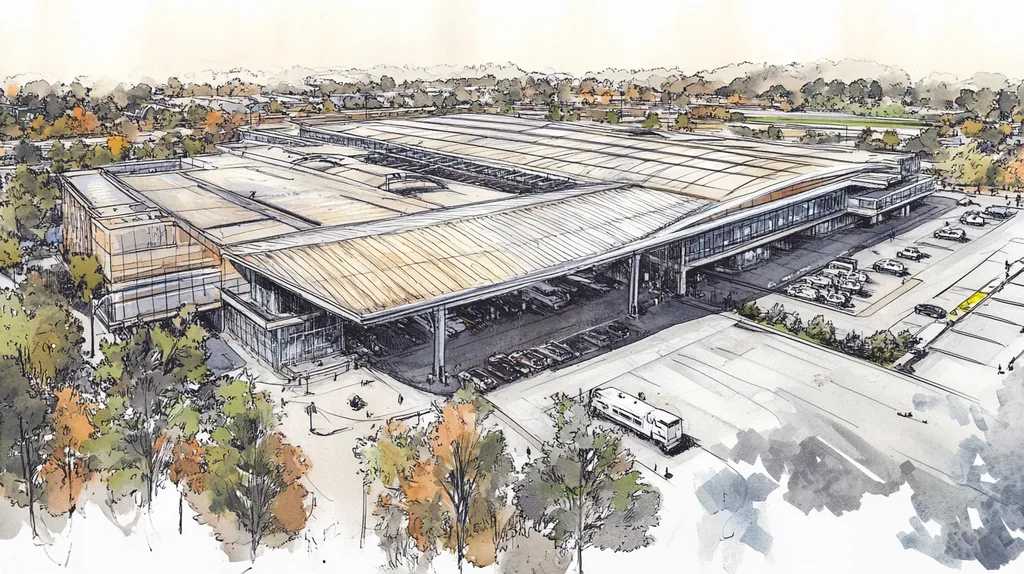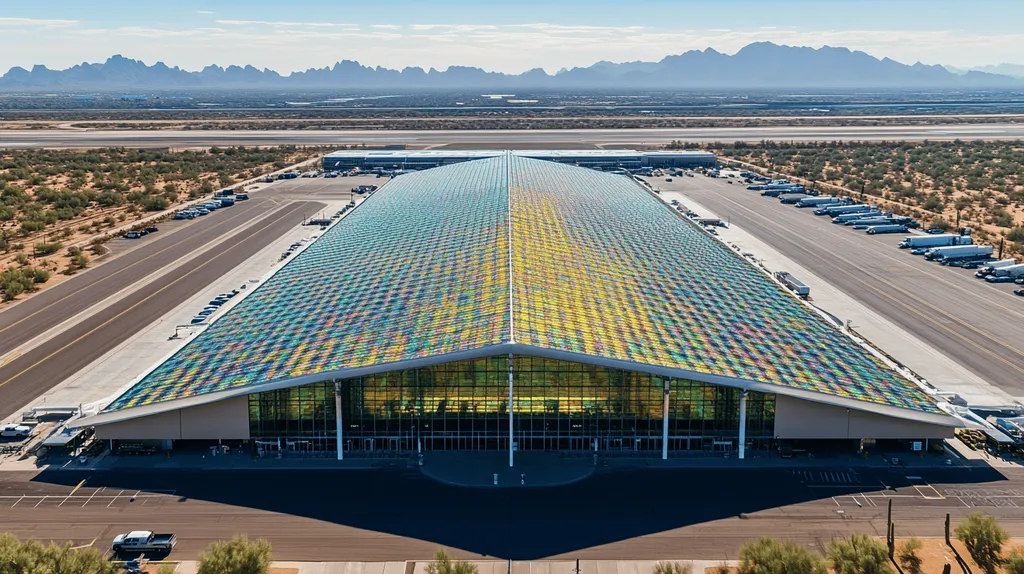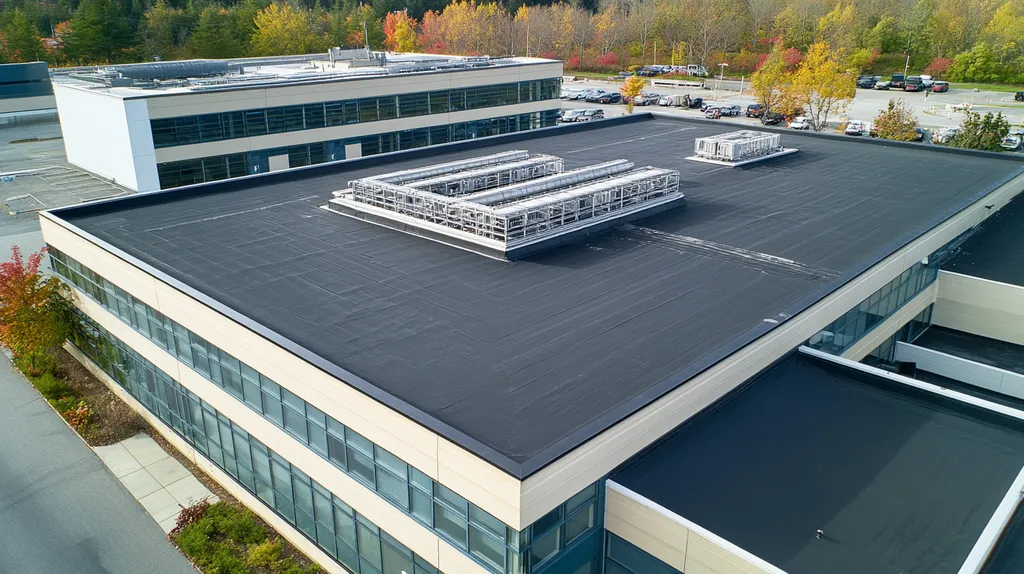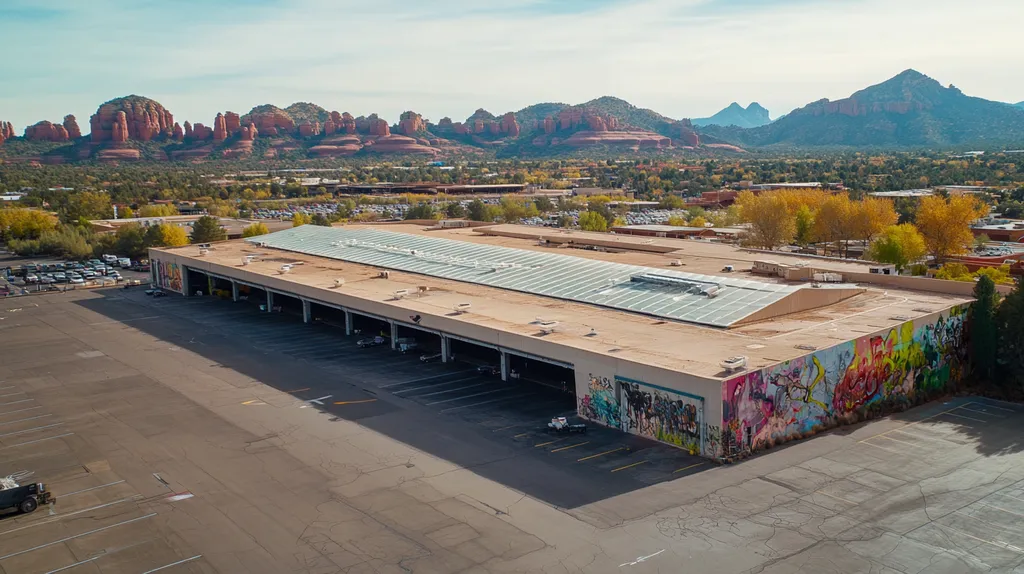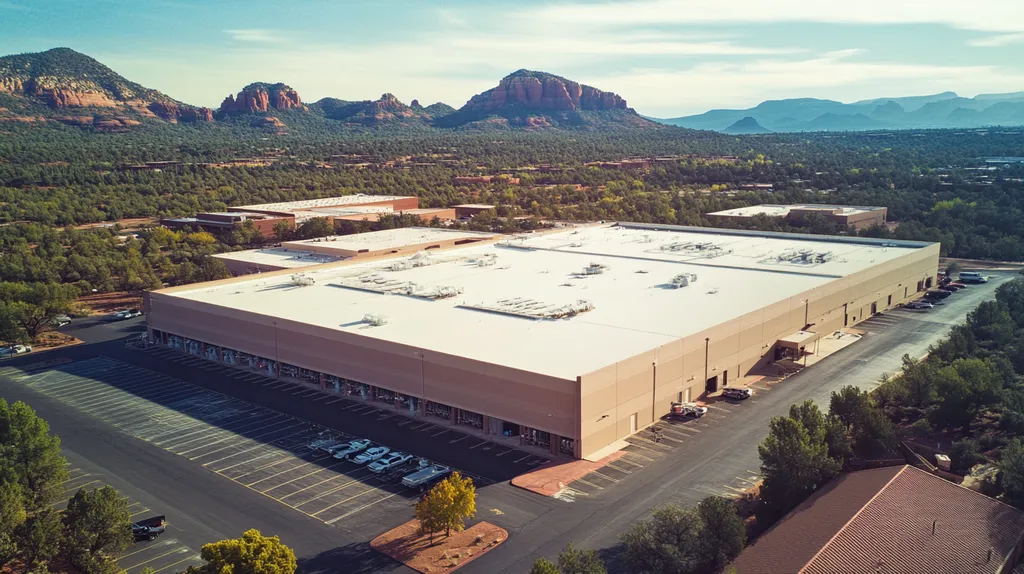Commercial building owners are hemorrhaging money through their roofs, with studies showing uncoated roofs can increase cooling costs by up to 30% annually. This preventable waste impacts both operational expenses and asset value.
While roof coatings promise significant energy savings, widespread misconceptions about their application and effectiveness often lead property managers to make costly mistakes.
By examining the real impact of commercial roof coatings on heating and cooling costs, this comprehensive guide separates fact from fiction to help building owners make informed decisions about their roofing investments.
SECTION 1: COMMON MISCONCEPTIONS
Many property owners mistakenly think that applying a roof coating is a universal solution for all roofing issues. This belief can lead to costly financial setbacks and compromised building integrity. For instance, the National Roofing Contractors Association estimates that poor coating decisions can drive energy costs up by as much as 30%. It’s essential to grasp the realities of roof coatings to make informed choices that genuinely enhance the building.
Myth: Coatings Are a Quick Fix
A widespread misconception is that roof coatings act as quick, inexpensive remedies for roofing problems. While these coatings can improve a roof’s performance, they cannot replace essential repairs. Overlooking underlying damage, like leaks or structural issues, can trigger even larger and more expensive problems later on.
For example, if a building owner applies a coating over a leaking roof without addressing the leak, moisture may become trapped underneath the coating. This scenario can lead to mold growth and accelerated deterioration, potentially resulting in a complete roof replacement sooner than anticipated.
Coatings perform best as part of a comprehensive roofing strategy rather than as stand-alone solutions. Property owners should first tackle existing damage before reaping the benefits a roof coating can offer.
By clarifying the limitations of roof coatings, building owners can better plan and allocate resources, ensuring these coatings enhance the roof’s longevity rather than jeopardize it.
Misunderstanding Reflective Coatings
Another common misunderstanding revolves around reflective coatings. Many owners assume these coatings will dramatically cut energy costs without recognizing that their effectiveness depends on various factors. Reflective coatings can indeed help lower roof surface temperatures, but their actual impact is influenced by climate, building location, and roof design.
In particularly hot climates, a reflective coating can reduce cooling costs by minimizing heat absorption. However, property owners in cooler regions may see little to no energy savings. This highlights the need for a tailored approach when selecting coatings that meet specific building and environmental demands.
Moreover, the quality of the installation is key to optimizing the performance of reflective coatings. Proper application techniques can maximize reflectivity, leading to the expected energy savings. Conversely, a poorly applied coating can severely diminish its performance and waste valuable resources.
To ensure reflective coatings align with energy-saving objectives, building owners should conduct thorough evaluations and consult roofing professionals. This strategic approach can prevent misallocation of resources and amplify the benefits realized from various coating applications.
Believing All Coatings Are Equal
The belief that all roof coatings are identical can lead to poor decision-making. Just as different paints serve distinct purposes, not all coatings offer the same protection or durability. Each coating type features unique properties, tailored to specific roofing materials and environmental conditions.
For example, silicone coatings are ideal for flat roofs and provide excellent water resistance. Conversely, acrylic coatings are more versatile but may struggle in extreme weather conditions. Choosing an incorrect type could result in reduced effectiveness and a diminished roof lifespan.
Investing in high-quality coatings that correspond to the roofing system and local climate can improve energy efficiency. Understanding the differences among coatings empowers property owners to make informed choices that safeguard their investments.
Additionally, routine inspections and assessments should accompany any coating application. Monitoring the condition of both the coating and the roofing system is vital for ensuring that performance expectations are fulfilled over time.
SECTION 2: PRACTICAL IMPLICATIONS
As energy costs continue to rise, commercial property owners must tackle this urgent issue head-on. Heating and cooling systems consume a considerable fraction of overall building energy expenses. By integrating roof coatings, owners can significantly cut these costs, improving both the efficiency of their buildings and the comfort of their occupants. This section explores how roof coatings affect HVAC systems, enhance indoor comfort, and extend roof longevity, showcasing this eco-friendly solution’s many advantages.
Impact on HVAC Systems
The HVAC system is essential for ensuring a pleasant indoor atmosphere. When roofs heat up due to inadequate insulation or dark surfaces, HVAC units must work overtime to keep the interior cool.
Reflective roof coatings can lower roof temperatures by up to 30 degrees Fahrenheit, providing much-needed relief for HVAC systems. This reduction not only eases strain on equipment but also extends its lifespan.
As a result, a more efficient system consumes less energy, meaning lower utility bills for property owners. The advantages of reduced operations costs paired with improved efficiency underscore the importance of investing in roof coatings.
By incorporating coatings into their maintenance plans, owners not only secure their buildings but also prevent costly HVAC repairs and replacements, highlighting the necessity of proactive property management.
Effects on Indoor Comfort
Creating a comfortable indoor environment is vital for commercial spaces, directly influencing employee productivity and tenant satisfaction. Buildings with excessively hot roofs can translate into uneven temperatures and discomfort within.
High-quality roof coatings promote consistent indoor temperatures by reducing heat buildup. This helps to minimize hot spots, creating a more enjoyable atmosphere.
Moreover, enhancing occupant satisfaction can significantly impact tenant retention. Properties that emphasize comfort through smart roofing choices display a commitment to the well-being of their occupants.
Investing in roof coatings not only raises comfort levels but also boosts the overall attractiveness of the property, making it more appealing to potential tenants and allowing for possible increases in rental rates.
Influence on Roof Longevity
Maintaining the integrity of the roof is key to the overall upkeep of commercial properties. Traditional roofing materials often deteriorate from UV exposure, harsh temperatures, and severe weather conditions.
Roof coatings serve as a protective barrier against these environmental stressors, significantly prolonging the lifespan of the roofing system. With proper maintenance, a well-coated roof can outperform an uncoated one by as much as 15 years.
This longevity not only defers the need for costly replacements but also contributes to substantial savings for property owners. Therefore, investing in roof coatings is a strategic approach not only for immediate financial relief but also for long-term asset management.
Prioritizing roof coating applications translates to enhanced property durability and value retention in today’s competitive market.
SECTION 3: COST OF MISINFORMATION
Neglecting roof coatings can lead to significant financial consequences that often go unnoticed. Without effective coatings, commercial buildings can incur heating and cooling costs that are up to 30% higher than those of their coated counterparts. This oversight can result not only in potential revenue losses but also in unwelcome downtime due to premature roof replacements. Here, we will delve into the financial repercussions of ignoring coatings, the hidden costs associated with inefficient roofs, and the opportunity costs that arise from delaying maintenance.
Financial Consequences of Ignoring Coatings
The financial ramifications of neglecting roof coatings can be staggering. When roofs lack protective coatings, they face accelerated wear and tear, leading to more frequent repairs or even complete overhauls. According to the U.S. Energy Information Administration, uncoated commercial roofs can waste thousands each year in energy costs.
Furthermore, property owners frequently underestimate the long-term savings that come from investing in quality coatings. A well-chosen coating can offer a substantial return on investment in a short timeframe, primarily through reduced energy expenses. For instance, if a company spends $10,000 each year on energy for a non-coated roof, switching to a coated solution could save approximately $3,000 annually. Over five years, that’s a remarkable $15,000 in savings, all while extending the roof’s lifespan.
In short, not investing in roof coatings can lead to an unsustainable financial model, where escalating costs overshadow initial savings.
Hidden Costs of Inefficient Roofs
Inefficient roofs bring along a host of hidden costs that can severely affect a property’s financial health. In addition to elevated energy bills, these roofs often incur increased maintenance expenses due to leaks and structural damage. Studies have shown that uncoated roofs require repairs nearly 50% more frequently than their coated counterparts.
Alongside these maintenance costs, business operations can suffer disruptions due to roof failures. When leaks occur, the immediate need for repairs often halts business activities, leading to lost revenue and frustrated customers.
Insurance costs may also rise as insurers recognize the increased risks associated with poorly maintained roofs. The likelihood of claims can lead to higher premiums for buildings lacking proper roof protection.
In summation, the financial burden of inefficient roofs extends well beyond energy expenses, posing a threat that property owners should not take lightly.
Opportunity Costs of Delayed Maintenance
When roof maintenance is postponed, the opportunity costs can be significant and far-reaching. Each day without adequate roof attention increases the risk of severe damage that requires costly repairs. This scenario creates a domino effect, forcing property owners to deal with unexpected expenses much sooner than anticipated.
Resources spent on emergency repairs could have been directed toward strategic investments such as high-quality coatings that enhance property value and appeal. Buildings with professionally applied coatings tend to command higher lease rates and attract quality tenants, thanks to their energy efficiency and improved aesthetics.
Moreover, neglecting timely maintenance elevates the risk of not meeting local building codes or sustainability regulations, setting the stage for potential fines or diminished property values. These repercussions can ultimately impact the bottom line.
Thus, the opportunity costs linked to delayed roof maintenance underscore the importance of proactive solutions like coatings. Smart decisions made today can lead to significant benefits in the future.
SECTION 4: REALITY CHECK
As energy prices soar, the pressure on building owners to adopt effective cost-cutting measures is intensifying. Roof coatings present a viable option for significantly reducing heating and cooling expenses, paving the way for improved financial management. Research indicates that reflective coatings can lower roof surface temperatures by as much as 30 degrees Fahrenheit, leading to impressive energy savings. In this section, we will examine how these coatings function, the advantages they offer based on local climate conditions, and the variety of materials suitable for different roofing needs.
How Reflective Coatings Work
Reflective roof coatings are ingenious solutions designed to minimize heat absorption by using highly reflective materials that deflect sunlight away from the roof surface. This not only keeps roofs cooler but also results in reduced interior temperatures and less reliance on air conditioning systems.
Many commercial property owners underestimate the potential impact of these coatings. Studies reveal that reflective roofs can slash cooling costs by as much as 50% in hot climates. Such energy efficiency not only decreases utility bills but also prolongs the lifespan of roofing materials.
In contrast to traditional dark roofs, which tend to absorb heat, a properly applied light-colored or specially formulated coating significantly enhances reflectivity. Making this simple adjustment could translate into substantial financial advantages, marking it as a smart investment for property managers.
Facility managers benefit from comprehending the technical aspects of how these coatings work. The increasing amount of evidence supporting their efficacy underscores the practical benefits these solutions offer to commercial buildings.
Climate-Specific Benefits
The benefits of reflective roof coatings are closely tied to their geographic application. In regions that endure scorching summer temperatures, such as the Southwest U.S., these coatings shine in combating excessive roof heat, leading to reduced air conditioning costs.
However, reflective coatings are not solely beneficial in hot climates. Those in cooler regions find that these coatings can help minimize frost build-up during colder months, contributing to improved energy efficiency year-round.
Furthermore, some coatings are specifically engineered to withstand particular climatic challenges. For example, there are options that resist hail damage in storm-prone regions, thus enhancing durability. Recognizing these variations ensures that property owners can select the most suitable coatings based on their specific environmental conditions.
By strategically investing in roof coatings tailored to local climate considerations, building owners can achieve significant improvements in energy management and operational efficiency.
Material Variations and Uses
There’s a diverse range of roof coatings available, each designed for specific roofing types and applications. Acrylic coatings are favored for their ease of application and versatility, making them an attractive choice for many commercial properties.
Silicone coatings, known for their longevity and excellent waterproofing, are especially advantageous for flat or low-slope roofs where moisture accumulation is a concern. Utilizing these advanced materials can notably enhance the lifespan and effectiveness of the roofing system.
Additionally, polyurethane coatings offer robust protection for high-traffic areas, delivering exceptional durability against wear and tear from foot traffic and chemicals. The choice of material plays a crucial role in ensuring optimal performance and durability over time.
By understanding the various roof coating materials available, facility managers can select the best options to meet their unique needs. The long-term savings achieved through appropriate material choices can significantly bolster a building’s energy management strategy.
SECTION 5: EVIDENCE-BASED ALTERNATIVES
For commercial building owners, making the right choice in roof coatings is crucial. An ill-informed decision can escalate energy expenses, shorten a roof’s lifespan, and lead to missed financial incentives. It’s imperative to choose the right coating material and ensure expert installation. This section will explore optimal coating options, the significance of professional application, and present impactful case studies highlighting the benefits of these practices.
Choosing the Right Coating Material
Not all roof coatings are equally effective, and selecting the right material is essential for achieving optimal performance. Different climates and building types necessitate specific coatings. For instance, elastomeric coatings are particularly suited for areas with drastic temperature variations since they can flex without cracking.
Reflective coatings also play a pivotal role in energy efficiency by minimizing heat absorption. A white roof coating can lower temperatures by up to 50 degrees Fahrenheit, translating into meaningful savings during the hot summer months.
Investing in high-quality, energy-efficient coatings pays off in the long run, often offsetting their initial costs. These coatings are designed to withstand harsh UV exposure and weather conditions, leading to extended lifespans and reduced maintenance needs.
Engaging a roofing professional to assist in selecting the most suitable material for a building’s unique requirements is vital. This tailored approach ensures that the chosen coating delivers the best results.
Professional Installation Importance
Even the best materials can falter without skilled installation. Proper application is a crucial factor in a roof coating’s effectiveness. Untrained installers may neglect critical details, resulting in issues such as poor adhesion and early failures.
Surface preparation is a prime example of this; the roof must be thoroughly clean and dry before applying any coating. Professionals have the expertise and tools necessary for achieving this essential step successfully.
Additionally, skilled installation often enhances both the longevity and warranty coverage of the coating. Many manufacturers require that certified applicators perform the installation to ensure warranty adherence, underscoring the necessity of professional expertise.
When installation is inadequate, not only do energy costs rise, but the potential for energy efficiency tax credits can also be voided, negatively impacting the overall return on investment.
Case Studies and Success Stories
Real-world examples vividly demonstrate the impact of high-quality roof coatings. For instance, a commercial property in Texas applied a reflective coating, achieving a remarkable 25% reduction in cooling costs within just one year. This not only boosted the building’s energy efficiency but also enhanced indoor comfort.
In another success story, a manufacturing facility in Ohio upgraded to a premium elastomeric roof coating, extending its lifespan by approximately 15 years. This significant extension brought substantial cost avoidance, considering the hefty expenses tied to roof replacements.
These instances underscore how strategic investments in quality materials and skilled application yield tangible benefits. Cost savings and prolonged roof life ultimately enhance property value and sustainability.
Building owners should take these success stories into account, recognizing how wisely chosen and expertly applied coatings can transform both their financial performance and building reliability.
SECTION 6: TEST AND VERIFY
The effectiveness of roof coatings cannot be taken for granted—it must be verified. A poorly applied coating not only leads to higher energy expenses but also raises maintenance costs. Buildings with confirmed roof coatings can experience energy cost reductions of up to 30% in certain climates. This section delves into the essential practices of conducting roof inspections, measuring energy savings, and monitoring long-term performance.
Conducting Roof Inspections
Regular roof inspections are crucial for assessing the state and effectiveness of coatings. Inspections should occur before and after application to identify potential issues early. Involving a qualified roofing professional ensures that they spot problems like poor adhesion or premature wear caused by environmental factors.
During these inspections, critical indicators such as cracks, peeling, or discoloration are evaluated, signaling possible deterioration. By addressing these concerns promptly, property owners can avert more extensive and costly repairs, maintaining the insulation and energy savings offered by the coating.
Advanced tools, such as infrared thermography, can help detect heat retention on the roof, providing detailed insights into the coating’s performance in reflecting sunlight. Such data allow owners to make informed decisions about necessary interventions.
In summary, conducting regular inspections fosters a proactive maintenance regime, ultimately extending the life of the coating and stabilizing energy expenses.
Measuring Energy Savings
Quantifying the energy savings from roof coatings can be achieved through several measurement methods. A straightforward approach involves comparing utility bills before and after the coating application. By analyzing energy consumption patterns, noticeable reductions serve as indicators of the coating’s effectiveness.
Employing energy modeling software provides a more nuanced prediction of potential savings by factoring in variables like local climate, building orientation, and roof materials. This software offers a clearer picture of anticipated energy savings over time.
Some property owners invest in smart energy monitoring systems that provide real-time data on energy usage. This approach enables quick adjustments and tracking of long-term savings, ensuring accountability in achieving energy efficiency goals.
Ultimately, measuring energy savings is essential for justifying the investment in roof coatings. Tangible results reinforce the decision to apply these coatings and can even attract tenants interested in sustainability.
Monitoring Long-Term Performance
Monitoring long-term performance is crucial for understanding the ongoing advantages of roof coatings. Property owners should establish a routine for annual reviews to assess the durability and functionality of the coatings.
Evaluating the total cost of ownership is vital as it encompasses initial savings alongside expenses for repairs or premature replacements. Tracking performance data over the years can conclusively demonstrate long-term benefits, validating the roof coating’s efficiency.
Utilizing performance warranties from manufacturers provides additional assurance, clarifying expected lifespans and optimal maintenance conditions. Regularly reviewing these warranties keeps property owners informed of their responsibilities toward maintaining the coating’s effectiveness.
In conclusion, long-term monitoring equips property owners with critical knowledge about their roofing systems. This vigilance ensures energy benefits remain intact and addresses any emerging issues promptly, ultimately extending roof life and controlling costs.
The Bottom Line
With commercial buildings wasting up to 30% of their heating and cooling costs through poorly maintained roofs, the financial stakes of proper roof coating could not be higher.
Studies consistently demonstrate that quality roof coatings, when properly selected and professionally installed, deliver measurable returns through reduced energy consumption, extended roof life, and improved indoor comfort.
The evidence is clear: investing in appropriate roof coatings is not merely an option but a crucial business decision that directly impacts both operational costs and asset value.
Building owners who continue to delay coating implementation risk falling behind competitors while shouldering unnecessary energy expenses that compound year after year.
The time for action is now, as energy costs continue to rise and environmental regulations become increasingly stringent.
FREQUENTLY ASKED QUESTIONS
Q. Do coatings provide a universal solution for all commercial roof issues?
A. No, roof coatings cannot solve all roofing problems. They are meant to enhance performance but cannot replace necessary repairs. Addressing underlying issues, such as leaks, is crucial before applying a coating to avoid further damage.
Q. How can a commercial roof coating impact HVAC efficiency?
A. Roof coatings can significantly lower roof temperatures, reducing the workload on HVAC systems. By decreasing heat absorption, they help maintain indoor comfort while also extending the lifespan of heating and cooling equipment, which leads to lower energy bills.
Q. What are the financial consequences of ignoring industrial roof coatings?
A. Neglecting roof coatings can lead to higher energy costs and frequent repairs, which become financially burdensome over time. Uncoated roofs may waste thousands in energy expenses, driving down profitability while increasing maintenance demands for property owners.
Q. How do reflective coatings help with energy management for commercial roofs?
A. Reflective coatings work by deflecting sunlight, significantly reducing heat absorption. In hot climates, this can decrease cooling costs considerably. Making use of these coatings can result in effective energy management and a noticeable improvement in building comfort.
Q. What should building owners know about roof coating materials?
A. Different materials serve varying needs based on building types and climates. For instance, silicone is excellent for flat roofs, while acrylic is versatile and user-friendly. Understanding these differences can ensure better performance and longevity for the roof.
Q. Why is professional installation important for commercial roof coatings?
A. Professional installation ensures that coatings are applied correctly, maximizing their effectiveness and lifespan. Poor application can lead to adhesion issues and quicker deterioration, ultimately affecting energy efficiency and the potential for warranties.
Q. How can building owners verify the effectiveness of their roof coatings?
A. Regular roof inspections and energy usage comparisons help gauge effectiveness. Measuring energy savings through utility bills or smart systems can also provide insights into how well the coating performs, allowing for proactive maintenance.
Q. What are some key benefits of using roof coatings beyond cost savings?
A. Beyond cost savings, roof coatings enhance building durability, improve occupant comfort, and increase property value. They protect against severe weather and extend overall roof lifespan, which contributes to sustainability and lowers environmental impact.

